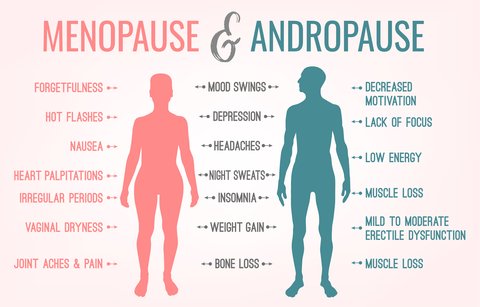Many of us dread getting older. Once you hit a certain age (for me it was 35), birthdays aren’t as fun as they used to be and the idea of aging (wrinkles and laugh lines and gray hair oh my) is more terrifying than you ever realized it could be. Sure, you’re grateful to have the luxury to enjoy another year on this earth, and sure, you are grateful for so many aspects of your life and family. But also, being young is awesome, and getting older is, well, less awesome. Or at least, that’s what we subconsciously start to believe.
You hit your mid-life years and BOOM — something shifts. Things that used to make you feel happy, fulfilled and purposeful (your job, your kids, your hobbies, your spouse…) suddenly might make you feel like crap. It’s a phenomenon that affects both men and women in their 40s and 50s, and it can strike unexpectedly at any time during those complicated years. We’re talking about the dreaded midlife crisis.

Most of us have similar visuals when we think about what a midlife crisis is. First of all, you probably picture a man, because no one seems to pay much attention to a woman going through any sort of emotional crisis. But we digress. Prompted by sudden hair loss or a receding hairline, panic sets in. So the man goes for the obvious fix — he surrounds himself with young, attractive (read: half-naked) women, turns in his sensible sedan for a flashy sports car, goes on a diet, and generally ruins his life in all aspects, from his marriage to his career, in an effort to prove society wrong and reinvent himself as a young, desirable man. You see it in movies and in reality. The mid-life crisis is real.
While a midlife crisis might look very different for a woman – you rarely see a woman leaving her husband and kids at home and picking up a young hot piece of you-know-what at a bar, then driving off in a red corvette – it’s still a very common and very real occurrence. Which leads us to the really important question: what can you do to turn that midlife crisis into a midlife revelation?
So What Exactly is A Midlife Crisis and When Does it Happen?
While it might seem like a convenient way to excuse an unfaithful husbands’ behavior, or like an emotional experience invented to make rom-coms more complicated and entertaining, the midlife crisis is a real thing. In fact, scientists and psychologists have been researching the topic for decades.
As per the L.A Times, the phrase “midlife crisis” was first coined by psychoanalyst and social scientist Elliott Jaques in 1965. His findings were shared in an article “Death and the Midlife Crisis,” published in 1965 in the International Journal of Psycho-Analysis. He argued that normal adult development often includes a period of intense emotional struggle during one’s middle years of life.
Think about a U-curve graph, where there are peaks at the beginning and the end, with a dip in the middle (the bottom of the “U”). That’s what a midlife crisis is like. It’s not a perpetual state of dissatisfaction, and it’s important to note, it’s not a permanent state either. It’s a brief period of discontent where one’s outlook on life or their satisfaction with what they have achieved, what they have experienced and who they have become is no longer enough. The disappointment doesn’t always strike as an instant crisis or a drastic change overnight. It often occurs as a constant drizzle or a gradual shift in mood and outlook, but still, the change happens and it can be devastating.
A worldwide study of two million people spanning 80 countries found that generally speaking happiness occurs on a U-curve. We experience higher levels of happiness at the beginning and ends of our lives, with periods of depression, turmoil, dissatisfaction and unhappiness occurring in midlife. The study, published in the journal Social Science & Medicine, was conducted by economists Andrew Oswald from the University of Warwick in England and David Blanchflower from Dartmouth College. They found that this pattern exists all over the world and midlife depression can affect all kinds of people, both men and women, in all kinds of communities, family situations (married and single, kids and no kids), socioeconomic groups and cultures.
“Some people suffer more than others but in our data the average effect is large,” said study author Professor Andrew Oswald. “It happens to men and women, to single and married people, to rich and poor, and to those with and without children.”
In terms of when a midlife crisis occurs, research suggests that women’s happiness bottoms out around 40, while men’s reaches a low around age 50. The length of this crisis varies from person to person, and of course, because everyone is different, it doesn’t always strike at the same age for every man or woman. But generally speaking, most women begin to feel the pressure and disappointment of a midlife crisis in their 40s.
If it makes you feel better, this is not a phenomenon that is uniquely human according to research.
Oswald and four other scholars, including two primatologists, conducted further research and found a U-shaped curve in chimpanzees’ and orangutans’ state of mind over time, similar to their findings with humans. From questionnaires completed by zookeepers, researchers and animal caretakers they found that the apes’ well being bottomed out at ages comparable to between 45 and 50 in human years. These findings, published in a 2012 paper, “imply that human well-being’s curved shape is not uniquely human and that, although it may be partly explained by aspects of human life and society, its origins may lie partly in the biology we share with closely related great apes.” Mind. Blown.
Okay, so a midlife crisis is very real and very common. But what can we do about it? If you are a woman entering her midlife years and you want to be as prepared as possible to handle such an emotional shift and a new phase of life, what can you do to take back control of your life and make the most of your midlife years? How do you take you midlife transition from a place of depression and mourning of your younger years and transform it into a state of empowerment and a chance to start over?
Reframe How You Think About Your Life Stage
One of the first steps to turning a midlife crisis into less of a crisis and more of a revelation is to reframe how you think about this phase of your life. Maybe you are getting older, and maybe the way you feel inside and out is going to shift as you age, but remember that no one, male or female at any age, is a fixed being who will stay the same throughout their entire lives. People evolve, grow, change, then change back, then shift again throughout their lives. When you hit your middle years, don’t look at your current state, shape or situation as the end. Look at it as a jumping off point. Instead of thinking about what you’ve done wrong or what you are unhappy with in your life, think about how you want to reinvent yourself.
Life in your 40s and 50s is not what it once was, and women in particular are no longer expected to just succumb to the role they are supposed to play or to deal with dissatisfaction. More than ever women are being empowered to make a change in their lives and live their middle-aged years in whatever way they choose (not how society may deem appropriate).
Take comfort in other women who have been in your shoes, who are experiencing what you are experiencing, and who are sharing their stories. It can be a friend, a family member, or even a public figure who is sharing her truth and her advice. More and more women in the public eye are writing books and hosting talks to share their stories of reinvention and empowerment in their middle-aged years. Michelle Obama’s memoir Becoming sold 1.4 million in the first week alone, and has sold 10 million as of March 2019. She’s commanding who she is, what she’s been through and what she wants to do in the future.
Or look at Sheri Salata, the former Oprah Winfrey Network co-president and one of Oprah’s closest confidants for over two decades, who is releasing her debut memoir The Beautiful No: And Other Tales of Trial, Transcendence, and Transformation this summer. She writes about aging out of the 25 to 54 bracket, which is like a death sentence for anyone in the TV industry, and how she is devoting all her energy to letting happiness guide her midlife reinvention. “In this day and age, if you start taking care of yourself, it’s not unreasonable to think that the 50s might truly be halfway up the mountain. This may be the middle of your life, not the beginning of the long goodbye,” writes Salata.
Bottom line: you are not alone; other women have been where you are and have faced the transition you are facing. Try to look at this new phase of your life as an opportunity for reinvention and a chance to do what you always wanted to do, not as a failure to be who you thought you should be by this age.
Take Control of Your Hormones
A midlife crisis does not necessarily have to do with what you have accomplished (or failed to accomplish) and might have everything to do with what is happening on a chemical level in your body. That’s right — just as hormones impact how you feel during puberty, pregnancy, postpartum and beyond, hormones can trigger a midlife crisis as well. During perimenopause and menopause, your hormone levels shift drastically, and that intense hormonal change can be a huge part of the problem. Changes to hormone levels affect your sleep, your energy levels, your mood as well as your weight, memory and even anxiety levels. When all of those aspects of your overall wellness change or decline, of course you will naturally feel worse than you did before. You might lose interest in things that used to bring you joy, and you might have a decreased sense of satisfaction in your daily life.

Which is why balancing your hormones and taking back control of your estrogen and progesterone levels is such a crucial component to making it through a midlife crisis and transforming that crisis into a positive experience.
Hormone replacement therapy, which is treatment using medications containing female hormones to replace the ones the body no longer makes after menopause, has been around for decades to help ease the symptoms of menopause. In recent years some clinical trials have exposed some potential health risks of hormone replacement therapy, which is why medical advancements that provide a safe and effective way to manage your hormones are so important. One such advancement is from BioTE Medical, a company that has developed a bioidentical hormone replacement therapy (BHRT), which involves the use of hormone pellets that are inserted subcutaneously to balance female hormones.

Essentially, this treatment helps to deliver balanced levels of hormones to replicate the hormones your body has been making for your entire life, but those hormone levels have shifted due to menopause and aging. According to Dr. Gary Donovitz, CEO and Founder of BioTE Medical, this hormone therapy allows you to age, but age healthier so that you feel better by optimizing your hormones.
More balanced hormones means a more enjoyable aging process, and ultimately can help you use your midlife years as an opportunity for revelation rather than a crisis.
Focus on Gratitude, But Allow Yourself to Grieve
Many people who experience a midlife crisis have that moment where they feel guilty for what they are going through. They feel like they have nothing to complain about, and like they are being selfish or irrational or unfair for having any qualms about their life, a life that has served them well up until this point. But this is a part of the problem — guilt leads to a denial and people going through a midlife crisis just try to sweep their emotions under the rug rather than talking about what they are going through. In the end, if nothing changes, then nothing changes, and by not talking about it or not actually addressing what is happening, you’ll do yourself and others a disservice.

Allow yourself to feel your feelings. Allow yourself to grieve your youth or what you feel is lacking or fading away in your life as you age. Allow yourself to have those negative thoughts. And then try to balance those thoughts and emotions with gratitude. Think about what is good in your life. Think about what fills you up and makes you happy. Not what makes your family happy or your boss or your friends, but what makes YOU happy. Write it down. Add to your list daily. And then start to think about what you want to change. How do you want to reinvent yourself today or in the future? If something isn’t satisfying you anymore, what can you do to make it serve you better? It’s okay to feel both disappointment and gratitude at the same time. It’s okay to have some regrets but not harp on those mistakes and instead focus on moving forward. It’s okay to admit when something is wrong and it’s definitely okay to share your feelings and ask for help.
Remember that a midlife crisis is not the end; in fact, it’s not even the middle. It’s just a point on the happiness U-curve of life, as you transition from one phase of your life to another. It’s not the end of your happy life, but rather an opportunity to re-evaluate what brings you joy and how you measure your own worth. It’s a chance to reinvent yourself and to truly practice gratitude (and simultaneously make changes) in your life.
For Image credit or remove please email for immediate removal - info@belatina.com










































